This article focuses on the healthiest trailers. The first priority is that the trailer holds up to mold. If it doesn’t hold up to mold, no amount of natural wood, or wool, or other eco-friendly material really matters.
Conventional trailers are extremely mold-prone. They use wood within the walls, roofs, and floors with a design that is not airtight and often has a vapor barrier on one side which is a point of condensation. Condensation usually forms in the cavities. They are also prone to leaks.
The Designs That Best Hold up to Mold Are:
- Sandwich construction – Airtight cavities of metal or fiberglass with rigid foam insulation. Ideally laminated together.
- Fiberglass shell campers – Solid fiberglass body trailers are single or double hulls. A single hull has no hidden cavity where condensation or mold can form. The double hulls can work well too. I list brands that have minimal wood or where the wood does not become a mold risk.
Low-VOC Trailers:
No well-made trailer is extremely low in VOCs. Some are better than others.
The interiors of all-metal trailers can be lower in offgassing compared to trailers with other wall materials. But don’t underestimate the odors of the glues used in all metal trailers.
There is no getting around the offgassing. The best strategy is to give it some time to offgas or buy a used one if you are highly sensitive.
You certainly can compare models if you are chemically sensitive since we all are reactive to different chemical combinations. You definitely could find some brands more tolerable than others, even if the total VOC count is the same.
You should also use mitigating strategies like a “bake out”, and shellac to block the offgassing. Shellac is ideal on metal, fiberglass, vinyl, and many other materials. You can remove shellac later with alcohol.
Some brands of trailers are formaldehyde-free but that doesn’t mean they are not high in other VOCs nor does it mean they are built well to resist mold. One brand on this list, Living Vehicle, is formaldehyde-free as well as built well.
Updated Winter 2020/21
There is no affiliate or sponsored content in this post.
Trailers for Chemical and Mold-Sensitive Folks
1. Metal Travel Trailers
ATC Aluminum Toy Hauler
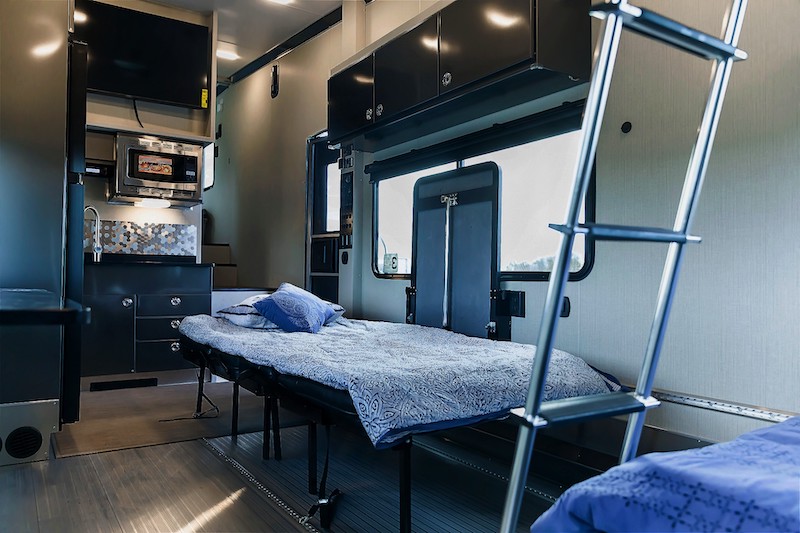
ATC is a mix between a cargo trailer and a high-end trailer. They look industrial compared to the Living Vehicle below (made by the same factory).
They claim to have no wood whatsoever and similar construction to the old Camplite design. They do have fiberglass insulation in the ceiling but the rest is foam.
The interior walls are Azdel.
The 24″ units have a bath, kitchen, eating area, couch that is made into a queen bed, and extra cabinets.
Bryan Rosner, a mold-sensitive person, has a good video tour of one here.
Cost – The 20 ft base model with no upgrades starts at $38,390 USD. The 24 ft models start at $41,530 USD. When a client priced it out with taxes and fees and the options she wanted, it came to 55k.
Weight – The 20 ft base model weighs 4,500 lbs.
Camplite
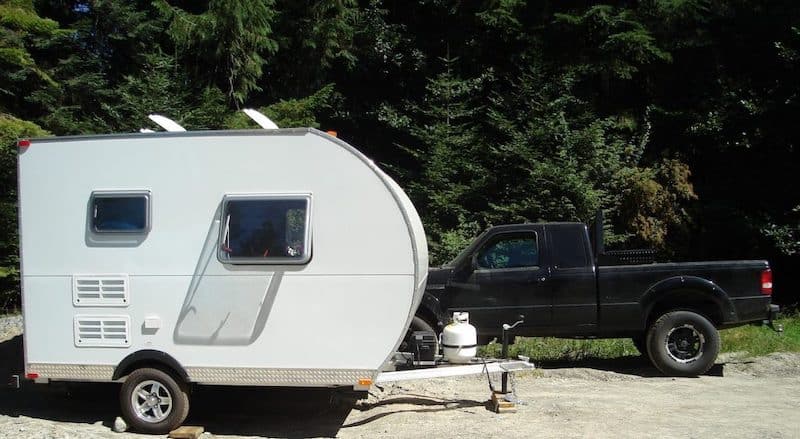
I had a Camplite by LivinLite travel trailer made to my specifications and you can find all the details about that here.
The key thing I look for in a trailer is moisture-proof walls and laminated sandwich insulation.
This laminated metal-foam-metal was the key to moisture-proof walls in these old models.
You may still find a used one with sandwich laminated walls before they changed the wall system. The company is now out of business.
Cost – You can find a used 2014 (21 ft) for 18,000 USD (or less, depends on the size).
Weight – A 24 ft model weighs about 3,100 lbs (depends on the year and configuration).
Hero Camper
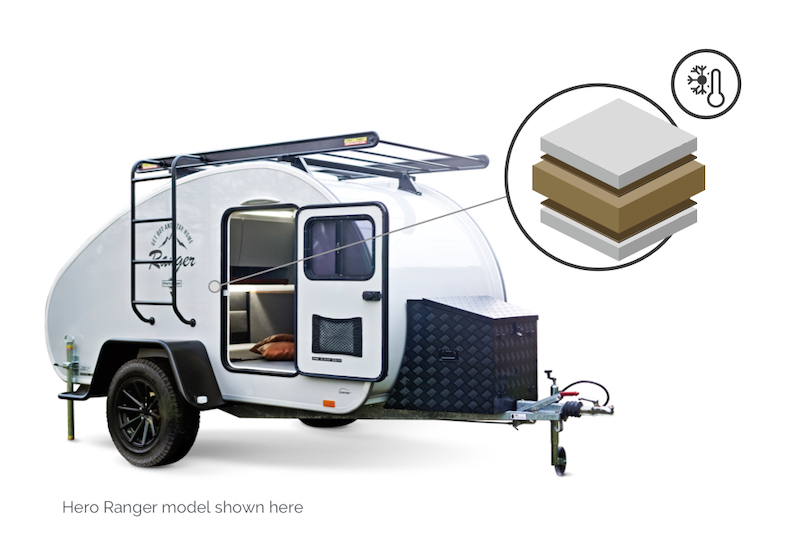
A new to me trailer, the Hero Campers are the most ideal design. The walls, floor, and ceiling are all a sandwich construction (laminated) just like the old Camplites, except those didn’t have insulated floors.
I was really excited to find this one. The envelope is constructed of fiberglass (on the outside)-foam-metal. Perfect. The best construction for mold prevention.
The interior is metal which is great for those with chemical sensitivities, though keep in mind all new trailers have offgassing from the construction adhesives, including formaldehyde in this case.
It has a small kitchen on the exterior, two options for heater types, no bathroom.
This is a European company, they have many dealers throughout Europe. They also have a dealer in Arizona, one in Australia, and one in Israel.
You can rent one in California on Outdoorsy.
Cost – The 2021 Hero Ranger is going for $21,995 USD through Tom’s Camperland in AZ.
Weight – The Hero Ranger is 15.8 ft and weighs 1,911 lbs.
The Safari Condo
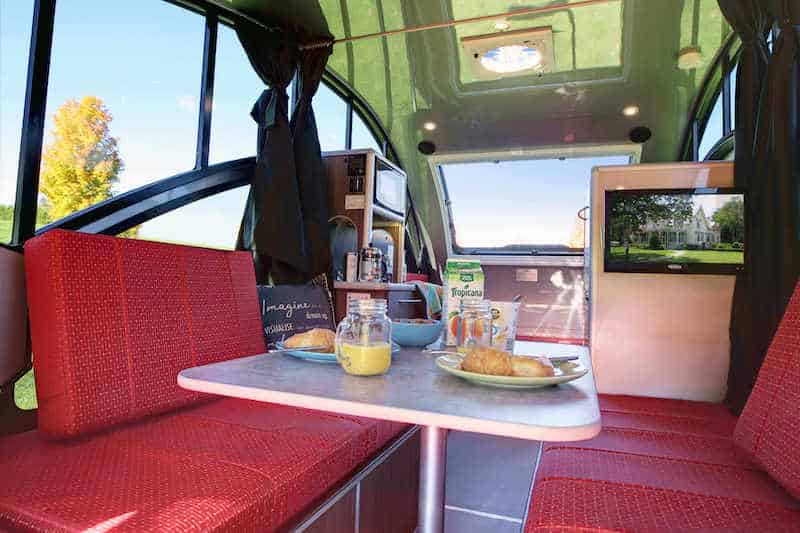
The Safari Condo is another great option to consider. A bit of a hidden gem, this one.
The roof and walls are made of a “sandwich-type material with a plastic honeycomb core laminated with Alufiber on one side and aluminum on the other.”
That main core is not foam or fiberglass insulation, it’s a honeycomb polypropylene.
Alufiber is an aluminum and fiberglass product.
This sounds like a very moisture-proof design to me.
They say the only materials used in the Alto body are aluminum, Alufiber, plastic, Formica, and glass. The furniture is mostly made of aluminum and composite materials.
They need a fair amount of time to offgas for most sensitive people, though some less sensitive have used them brand new. I have heard from one person who found this trailer to be higher in offgassing than most other trailers.
Cost – Their travel trailers start at $37,500 Canadian Dollars. The more popular 1713 model (17 ft) has the pop-up roof (built well) and that one is about $40,000 Canadian dollars.
Weight – The 17ft (1713) model is only 1,825 lbs.
Taxa Outdoors
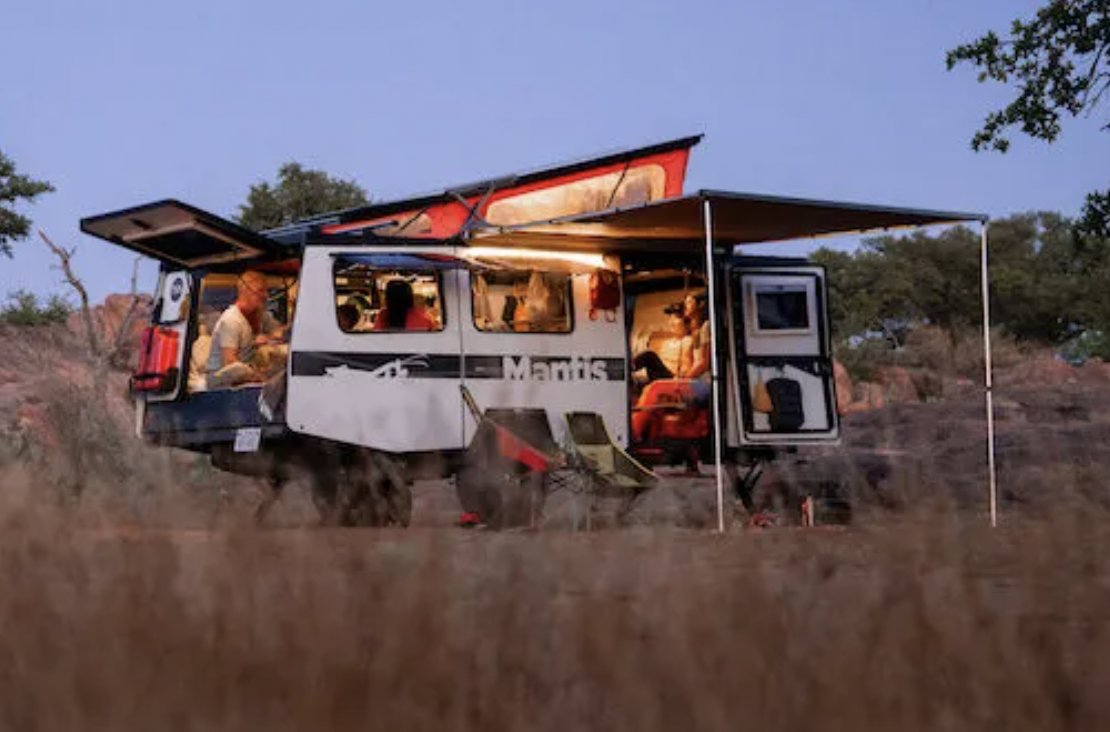
Taxa Outdoors makes three different models of travel trailers. The construction looks good in terms of mold resistance. The sides and roof are made from metals SIPS made of metal, EPS foam, and metal.
The floor is made of plywood sandwiched between a rubber flooring on the inside and ABS plastic laminated on the outside. Not quite as good as the walls but I would still consider this trailer to be a good option.
Cost – The largest model is called Mantis and it 19 ft long and goes for 46K in 2022.
Weight – The 19 ft trailers has a dry weight of 2,972 lbs.
Custom Metal Trailers
Customized
You can customize a small metal trailer custom-made in the style of the Camplite, or more like a tiny home on wheels. Customizing these structures tends to get very expensive. And it’s not common to find someone with this expertise to build them. It’s better to work with a company that makes metal trailers already and make some alterations.
Metal SIPS
I have also seen cargo trailers and larger homes on wheels custom-made with metal SIPS. This is metal-foam-metal laminated together. A very watertight construction if done well. It is supposed to have another siding on the exterior of the SIPS.
Porcelain Enamel
Another type of non-toxic trailer is porcelain enamel on steel. This is an extremely tolerable material but it is not cheap. It’s very rare to see a porcelain trailer for sale, many of them were made on poor-quality RV shells which is a shame because the porcelain enamel is highly tolerable on the interior.
If you find one for sale you may be able to use the interior to rebuild a trailer around.
Cargo Trailers
Joey, from HealClick, breaks it down to the essentials and delivers a safer trailer for $7000. Here is my post about my conversion.
There is a lot more that has to offgas in these simple trailers than you might think. They take about a year to offgas to minimal levels.
And they are way trickier to insulate than you think as well. Common brands have leak problems. More robust brands should be used if you are going to insulate it.
High-End Metal Trailers
Airstream
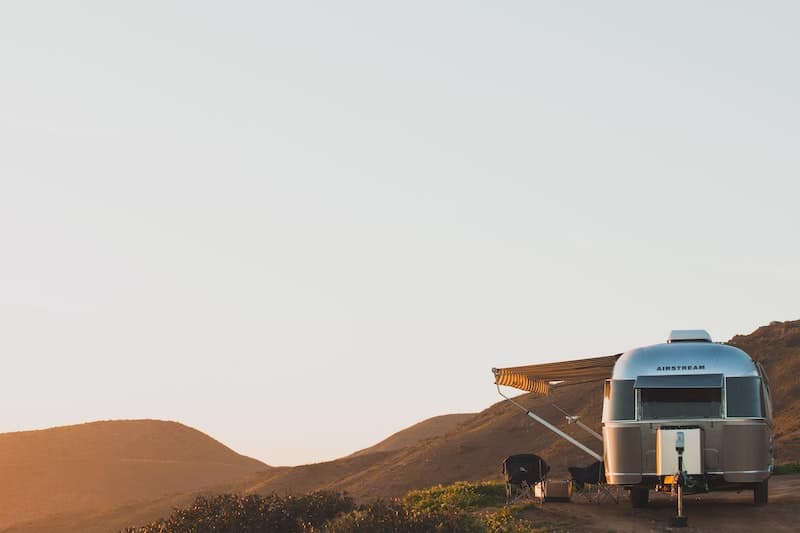
Airstreams with metal walls are far more tolerable for the chemically sensitive than most other trailer options that have a kitchen and bath.
The metal airstreams (they do have fiberglass ones now too) are metal walls and metal ceiling with, obviously, metal exterior skin. The flooring is vinyl over a composite subfloor (no longer plywood since the change in factory in 2020).
The offgassing is not too bad and does go down at a reasonable rate. The resale value is quite good for a trailer/RV.
I like the metal interior walls, they cut down on offgassing and they are way better made than your typical wood-framed crappy RV. The furniture looks like it’s mostly or entirely plywood (which is good) but the cushions are memory foam (which is not good because it’s higher in offgassing than regular foam).
Some of their showrooms are inside warehouses which may help preserve them.
However, this needs to be 100% airtight on the inside walls and the exterior walls to not have vapor get between those skins where it will be mostly doomed to not come back out. (Some caveats would be that if you never heat or cool this then it’s not really a worry, unless it actually leaks).
The shells are sealed really well right out of the factory and they do perform aggressive water testing on the shells. They then add fiberglass insulation and an interior metal skin.
I would be sure to check every opening on the interior shell as well to make sure it is sealed. That also needs to be airtight.
If you are rebuilding one you also need to seal this as well as they do in the factory. Seal up every seam, every opening, install airtight sockets, etc, then test again (with water or a blower door test), making sure it’s totally airtight. I would never try to rebuild/reno an Airstream. This is really a factory job.
You can prolong the life of any trailer by keeping a roof on it when stationary, not driving it in the rain, moving to climates that don’t require heating or cooling (heating is usually the cause of most of the problems in RVs but in this case with metal on both sides both heating and cooling can cause condensation if there is water vapor in the walls), and showering and cooking outside.
Always keep up with your inspection and sealing on the exterior and the interior.
You can find airstreams to rent on Outdoorsy and other sites, making this an appealing option that you can “test drive”.
I do think that they are still a strong option to consider, especially for folks sensitive to chemicals and mold. With a high resale, low initial offgassing, and an expected lifetime of a few years for extreme mold reactors it can work really well. The move away from plywood was a great move for them.
Cost: The aluminum airstreams start at $40,000 USD for 16ft. They have many sizes all the way up to 33 ft and about $170,000 USD.
Weight: The 16 ft aluminum model weighs 2,585 lbs and the 30 ft model weighs 7,788 lbs.
Living Vehicle
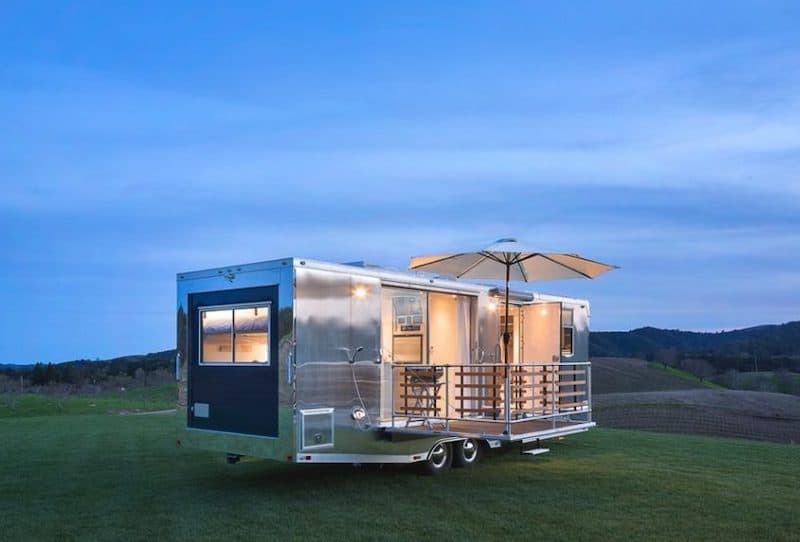
A newer company making well-tolerated trailers is Living Vehicle. They use polyiso foam insulation sealed with tape in the walls. The interior is almost entirely aluminum including the cabinets.
The countertops are Corian. The flooring is sheet vinyl by Armstrong (common in trailers but fairly high in offgassing – it may not work for many but they could customize this with another option). See my list of safe flooring for trailers.
The cushions are polyurethane, countertops are zero VOC. The offgassing of the trailer in general has been reported to be very low. It is formaldehyde-free.
This is a rare find because of the almost fully aluminum interior, no structural wood (no hidden wood in the new models for 2020, and no wood in cabinets, only in the table).
The walls are made of metal framing, metal exterior, and metal interior walls with polyiso foam on the interior side of the metal framing (with the air gap left behind, between the framing members).
The trailer also has a crawl space where the plumbing is very accessible. Even if there was a leak in the all-aluminum “basement”, it would be easy to clean up and easy to fix because of the access.
The company is open to some customization. I have spoken to them about this, if you would like help customizing the insulation, or interior materials like the flooring please get in contact.
The 2019 had wood in the floors.
Cost: The 2020 models are 29 ft and start at 200,000 USD.
Weight: They weigh in at 10,700 lbs, meaning you need a top-of-the-line truck to tow this.
2. Fiberglass Travel Trailers
Egg-shaped campers are usually made of solid fiberglass shells (either single or double hull) that are very mold-resistant and durable.
Many sensitive people say that fiberglass takes a year (or years) to offgas, but some find it offgasses to a satisfactory level in a few days or a few weeks. It’s very individual.
This is the best design to hold up to mold.
In terms of used trailers, molded fiberglass trailers are the best bet since the walls are less likely to become moldy with time.
Though fiberglass trailers can have problems with the wood subfloor if it’s not encased and if they have carpet on the walls that can go musty or get cross-contaminated.
Oliver
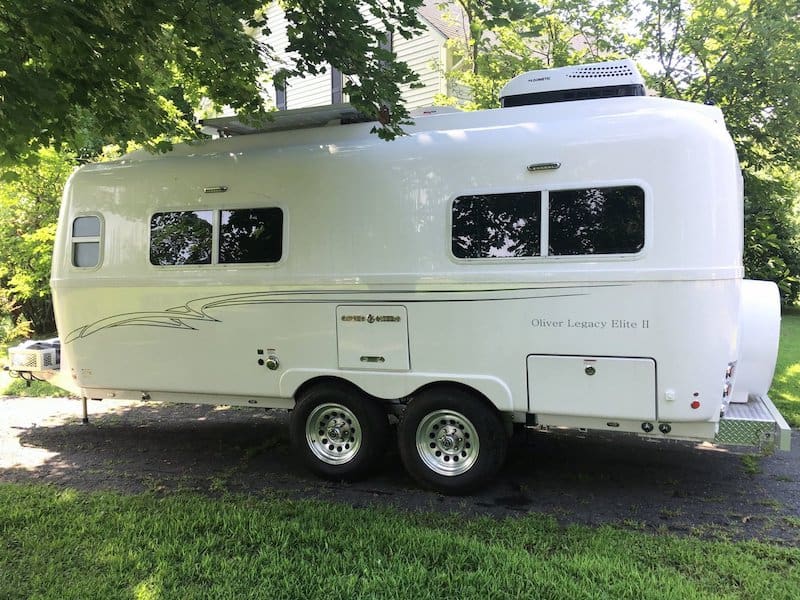
The Oliver brand travel trailer has been somewhat of a popular trailer for mold avoiders.
I like fiberglass campers with molded fiberglass furniture like Oliver Trailers. It makes for a simple, easy-to-clean, non-porous interior.
Very little wood is used, only in the cabinets.
They are double hull so they have a good R-value and can be winterized. The double hull overlaps at the seam, unlike Casita which is riveted at the seam.
The insulation between the hulls is polyethylene closed-cell foam, with an airgap between the hulls. There are weep holes at the bottom in between the hulls, meant for condensation that forms between the hulls to drain out.
They claim R-16. The windows are dual-pane.
It does not have wood products in the floor.
It does have a ducted HVAC system that is not accessible in the floor (or rather, only partially and with great effort). They use flex ducts in the floor for the heating. AC is on the roof.
Using the propane furnace is the only way to keep the pipes from freezing when the temperatures drop below 0 C.
Oliver uses vinyl flooring but they can make you one without the vinyl floor. They can make it without the cushions as well.
Recently they have added a composting toilet option.
Some mold avoiders have done well with this brand but there are also reports of leaks. It seems the windows are meant to weep out but often leak in instead. I also worry about the space between the hulls, which is meant for condensation but it seems like mold could form there if dust also accumulates.
You can see a tour of the factory here.
Cost: They have two models, one is 18.5 ft long and starts at 50,000 USD, the larger one is 23″ 6″ and starts at $57,500 USD.
Weight: The 18 ft weighs 3,700 lbs and the 23 ft model weighs 4,900 lbs.
Casita
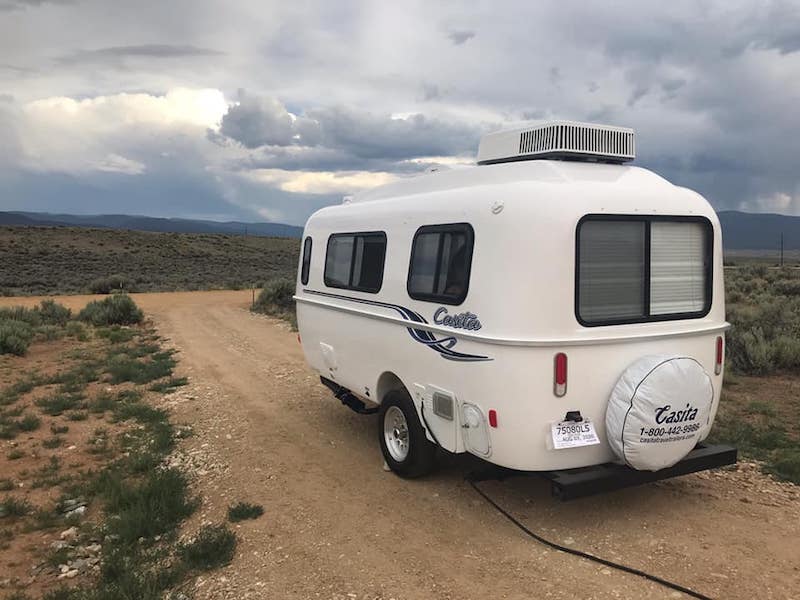
Casitas use a carpet and foam that is glued onto the walls and floor. At the time of writing, they would not customize one without that element.
The nylon carpet and glued-on polyurethane foam provide some insulation (R 6-7) and help prevent condensation.
Despite the carpet, many mold-sensitive folks have done well with this brand. It’s been a staple brand in the mold avoidance community since the beginning.
It has a simple design, single hull (nowhere for water to hide), and mostly all visible components.
The floor is wood but it is totally encased in fiberglass on all sides. In reality, there is very little wood inside, and only in the cabinet storage areas.
There is some offgassing but the reps said in an email “we do not use materials with formaldehyde.”
See Bryan Rosner’s video about his initial thoughts on the Casita for mold avoidance:
Cost: Casita makes two sizes. The most basic model is 16 ft and starts at around $18,500 USD. The 17 ft starts at around $19,500 USD.
Weight: Models range from 1,970 to 2,480 lbs.
Happier Camper
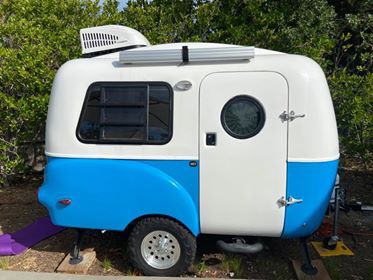
Happier Camper is another company to check out as they don’t use carpet or padding on the walls and the floors are fiberglass too!
No vinyl on the floors is a rare find and will be preferable for many folks.
It’s double-hull with Thinsulate in between the hulls.
The floors are composed of plastic honeycomb integrated with corrugated cardboard and fiberglass resin.
I like the modular nature of the HC1 interior. You can really simplify the interior if you need to or add the components that you need. The small units don’t include a shower but the larger ones do.
I’ve seen some problems with the first model (HC1). The friend who owns the one pictured had many problems with this unit when it was still brand new, and she claims the company took 7 months to make the repairs.
They are on the second model now in 2020 and have improved the doors and windows. I’m glad to see they have moved past the first prototype, made some changes, and are still going strong.
I would like to see positive reports on the newer rendition before recommending it as the first iteration had way too many problems.
Cost: The HC1 is 10 feet and starts at about $25,000 USD, the new 2020 Traveller is 14 ft and about $40,000 USD. These are highly modular so the base cost might not cover what you need – adding a kitchenette to the HC1 brings it to almost 30K, fully loaded it’s almost 34k.
Weight: The 10 ft model is 1,100 lbs, and the 14 ft is 1,800 lbs.
Trillium by Outback
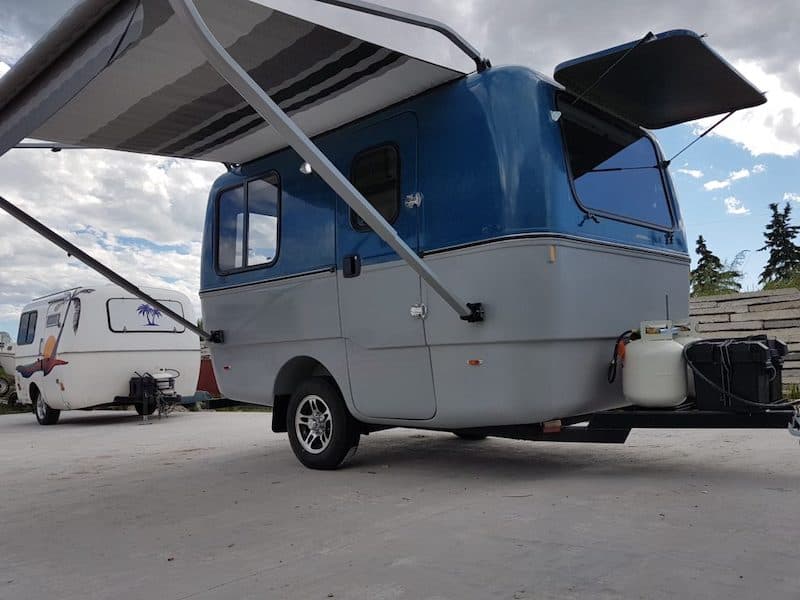
Trillium is another great brand, this one by The Outback. It is single-hull, made in Canada and they have been in business for many years.
They have closed-cell foam (probably polyurethane on the walls) with marine carpeting.
They were willing to build without plywood in floors but it was difficult to convince them to leave the padding off the wall.
The price is quite good (and even better for Americans because it’s in Canadian dollars).
They only have one size, but they have a couple of layouts.
Cost: The 14 ft trailer, starts at about $18,000 Canadian dollars. However, you need to add on some basics, including brakes and lights. If you add those and a bathroom as well it comes to a little over 20K CAD.
Weight: About 1,450 lbs average weight.
Trillium by L’air
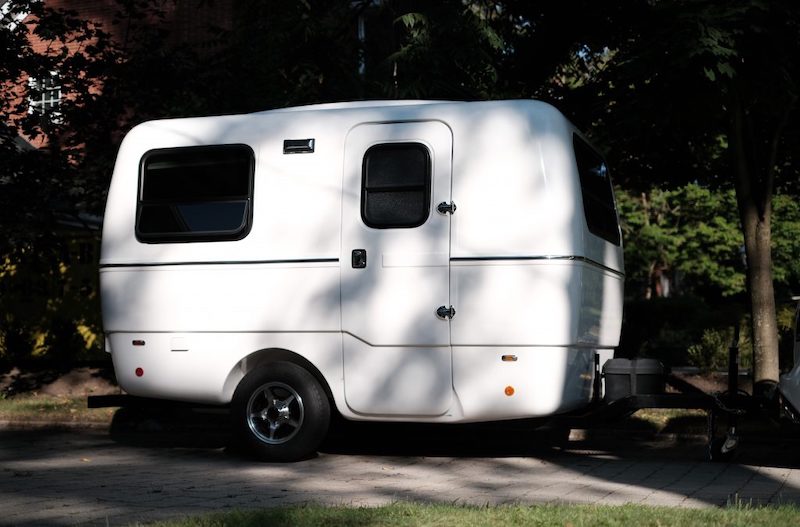
L’air is another Canadian company reviving the old Trillium trailer style.
Both companies have molds from the original Trillium factory in Ontario, Canada. L’air though has two sizes, the 1300 (15.5 feet) and 4500 (15.2 feet).
Their floors are a plywood core inside of the fiberglass structure – this is similar to Casita’s floors. It’s not prone to mold in my experience. There is no plywood exposed that can absorb moisture in the floor.
They have also eliminated plywood around the windows that was used as a filler to hold the windows in past models. Over time that plywood would become wet and rot. Instead, the windows are completely bonded to the camper body. This eliminates the leaks that develop around the windows in older Trillium campers.
The walls are covered with foam insulation and then marine vinyl which does not absorb moisture and is easy to clean. Many would prefer this to carpet on the walls.
There is always going to be some offgassing from fiberglass, including formaldehyde.
Cost: Starting at 26K CAD
Weight: 1300 lbs for the smaller model and 1600 lbs for the larger model.
Nest by Airstream
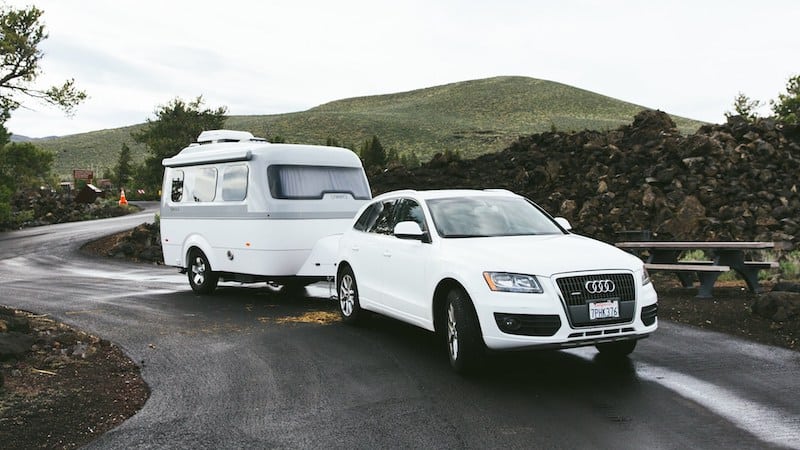
Airstream came out with a fiberglass model the Nest in 2018. It’s single-hull.
The construction of them is not super clear, one video describes the interior walls as “flex foil” (it’s not clear what that is), then a polypropylene “fabric” layer, then an interior olefin fabric which also means polypropylene or polyethylene.
You can see the fabric is rather smooth, I like this much better than the “carpeted” walls in all the other single-hull fiberglass trailers. Though I don’t understand what the insulation is behind the plastic fabric walls.
The cushion coverings are faux leather, I’m not sure if it’s vinyl (which offgasss quite a bit) or polyurethane (which doesn’t offgas very much at all). But it does look very mildew and mold-resistant.
The countertops are laminate with engineered wood products used in the cabinetry. The flooring is sheet vinyl. There is some offgassing of VOCs, including formaldehyde.
The heating system uses some ducting, but the AC system is the usual roof system.
There’s a full kitchen and wet bath.
Cost: The trailer comes in one size, it’s 16 ft and it’s about 43,000 USD.
Weight: 3,400 lbs.
HÉLIO Travel Trailer
The HÉLIO is not a single or double-hull fiberglass shell – instead, the walls are a sandwich of fiberglass-foam-fiberglass. The insulation value is R-7.
It’s called a molded fiberglass monocoque structure and it has a solid aluminum chassis. The floor is a plywood wrapped all the way around in fiberglass.
It’s made in Quebec.
Cost: Depending on size and features, the dealers are starting them at 31K CAD in Spring 2021.
Weight of the 02 Model: 1550 lb. Length: 14 feet 2 inches long
Other Fiberglass Trailer Brands in North America
Scamp – Made in MN. Plywood or OSB floor, with fiberglass underneath but not on top. Single hull, carpet walls with Reflectix behind them. Some wood in the shell. Old Scamp trailers had vinyl headliners but newer ones have fabric headliners. Video of the factory here.
Escape – Made in British Columbia, Canada. Fiberglass single-hull with frames constructed out of steel tubing. A factory tour shows hidden wood framing in the walls. Vinyl flooring. The headliner/wall covering is vinyl laminated onto 3/8” foam, creating an R-5 insulation value.
EggCamper – Double-hull. Bubble foil insulation between walls but not contiguous all around the trailer (only in some parts, not others). Owner Jim hurt his back and wasn’t building for a while. The website claims they will start building again.
Burro – Out of business in 2001, you may find used ones for sale.
Boler – Out of business in the 80s. You would only find very old trailers for sale.
If you need help choosing a trailer that suits your mold or chemical sensitivities you can contact me for a one-on-one consultation.
European Brands of Fiberglass Trailers (Caravans)
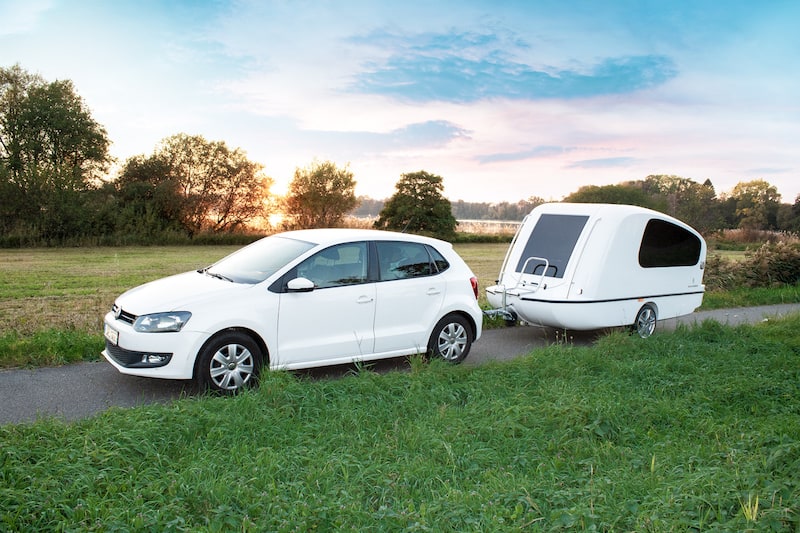
In Europe, the Wigmann is a good fiberglass caravan (as they call trailers there). It has a solid fiberglass shell with no seams on the outside. The construction is fiberglass-spray foam-fiberglass, airtight. I like this design a lot and have not seen this in North America. No wood, no metal. It has a 10-year warranty on water ingress.
Sealander is another European fiberglass caravan that is all fiberglass on the inside and out, exactly what I’d be looking for.
UK company Freedom Caravans has a fiberglass exterior but it is not the same as the molded fiberglass models. They have a 25-year warranty on water ingress which is very impressive. Though with a fiberglass exterior and a more standard wall, condensation could be a bigger risk than leaks.
3. Wooden Teardrop Trailers
Custom Built Teardrop
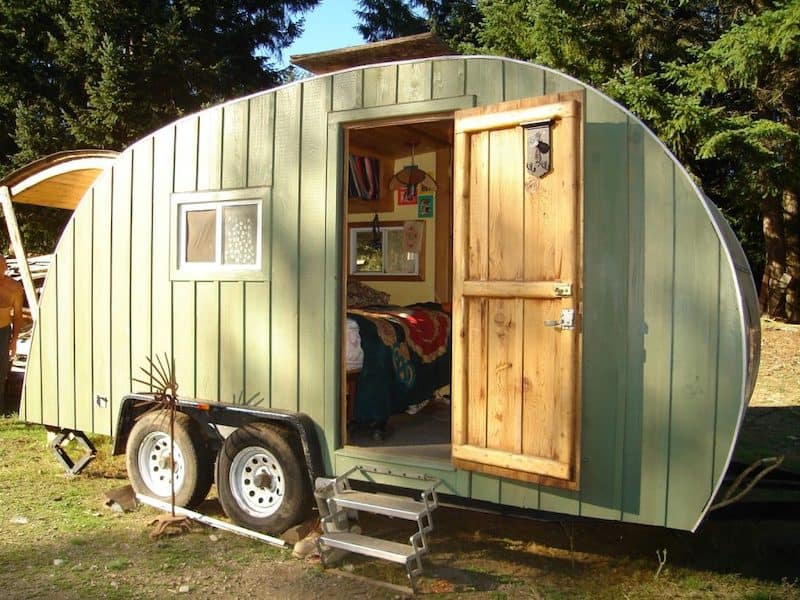
A small teardrop can be made of all wood like the trailer pictured that I showcased in this post.
The main challenge here is in heating climates the metal base, metal or membrane roof, and walls are all a challenge for mold prevention.
If this style of trailer is used in heating climates, you can build up off the metal trailer to avoid condensation and mold below, a technique illustrated in this post.
With the roof, you cannot have an exterior vapor barrier (and a double vapor barrier is too risky). You would need to fill in the ceiling with 2 part spray foam or rigid foam + spray foam as outlined in the van post.
The walls can be wood that is uninsulated, that can work. If you add insulation you get into much trickier territory.
This trailer would work really well in climates where you don’t heat the interior. Either AC use or no heating or cooling would mean you don’t have these issues with the metal trailer base and roof.
If you have high humidity use mold-resistant woods like cedar.
A company that makes trailers similar to this, Homegrown Trailers, uses wool insulation, this means they have a challenge in heating climates that in my opinion cannot be overcome. I cannot see any way that this would be mold-safe.
Cost: The 16 ft trailer came to $10,000 Canadian dollars in materials, the labor would be about an extra 10K. It has basic wiring, no plumbing, and a basic outdoor kitchen.
Weight: About 4,500 lbs.
DIY Teardrop
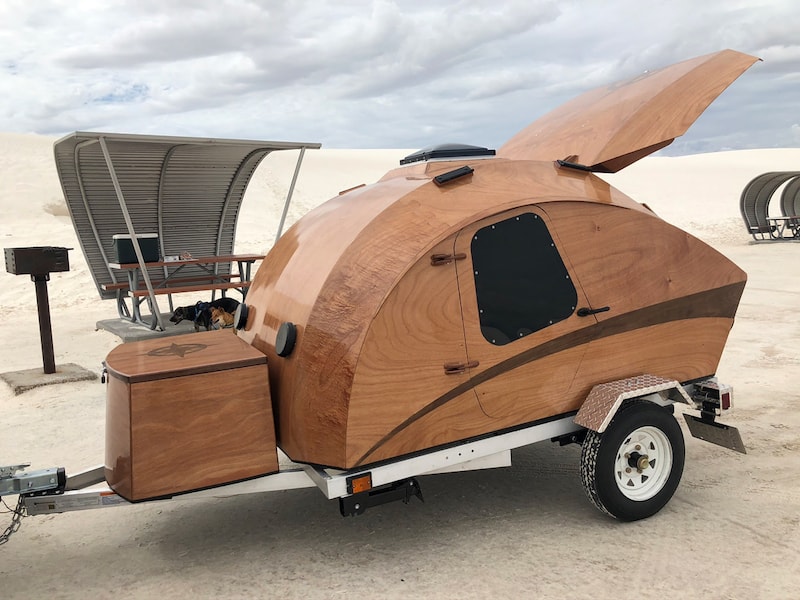
This is either a DIY kit or plans to make this wood-based teardrop trailer.
Although the main material is wood, it’s essentially a fiberglass trailer as it’s totally coated in fiberglass. This is built like a boat, and as long as all gaskets are done well this should not have moisture issues.
I have not seen this design in person, however.
The kit includes the wood, cut to the right sizes, fiberglass, epoxy, and all basic parts. All surfaces inside and out are sealed with epoxy.
It comes with plenty of epoxy to coat and seal the trailer, the necessary final finish – varnish and/or paint – is sold separately.
The metal trailer is not included.
It’s not quite as simple as it looks, it takes about 250 hours to complete.
Someone with an illness related to toxicity could do some parts of the build themselves but not the fiberglass and epoxy. And probably not the varnish either. Though epoxy finishes generally come to a complete cure, so even those with moderate chemical sensitivities might do well with this option once it’s cured.
Check out their website and videos.
Cost: $2619 USD for the kit or $199 for the plans.
Weight: The shell is 250 lbs when fully outfitted and accessorized. With the trailer weight included, it will come to 500-600 lbs.
Vans and Truck Campers
Cargo Van Conversion
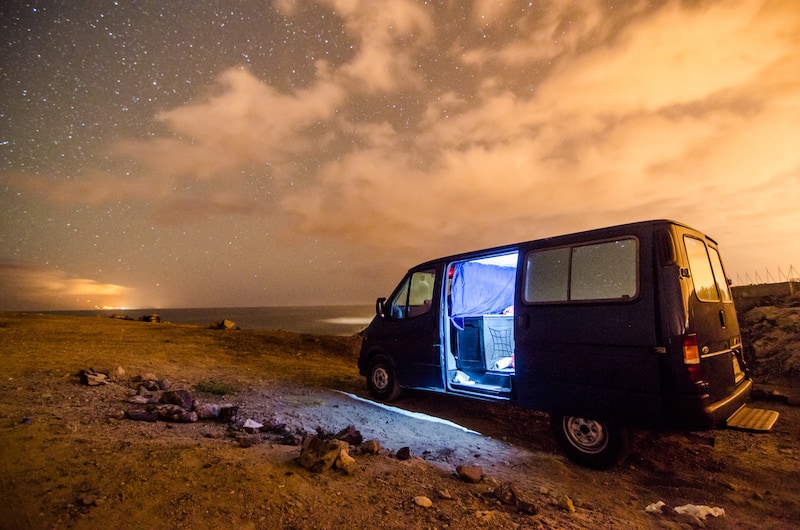
Here is my post on converting vans into campers in a mold-safe way.
Anything with an exterior metal wall is inherently tricky to insulate for weather where you heat the camper.
If you don’t heat the van in any way or only use AC, this is an easy solution.
The company Innovative Spaces can build out a cargo van. I don’t have direct experience with them.
Decommissioned Ambulances
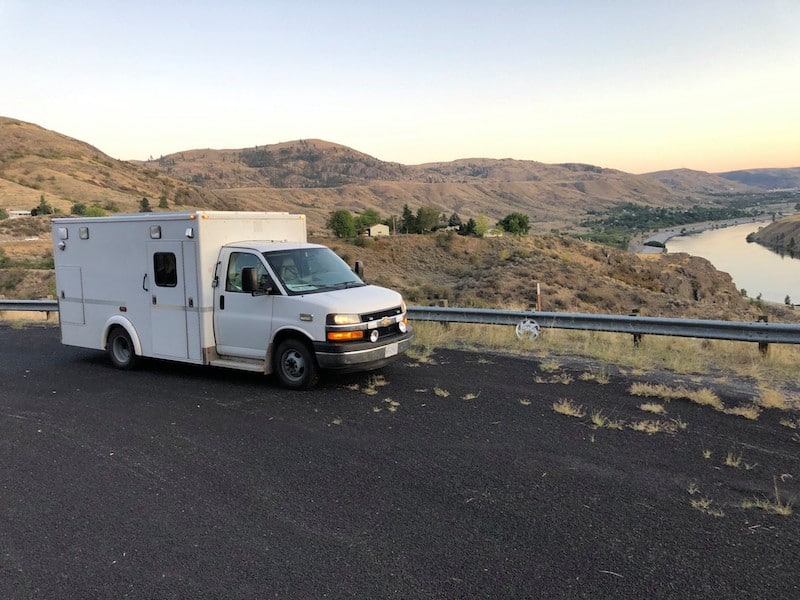
When I first saw Solona’s incredible recovery from CFS and MCS I was immediately impressed with this converted ambulance.
Looking more into how they are made, I found there are a few different ways of insulating them. I was not able to identify which company made this one.
It looks like most of them use rigid foam (polyiso) in the metal-framed walls and then use aluminum as the interior walls. Whatever they did in these walls to make them so air and vapor-tight, it’s working.
This mobile home has held up really well to mold – an unusual feat in the RV world.
On top of that, it was an absolute bargain. This is the best value for your money of any of the options here. If you can find one that is as mold-safe inside as this one you have struck gold.
Solona paid around 9K CAD for her used ambulance in the video (and pictured above).
This is similar or the same construction as the old Camplites, ATC, and Living Vehicle, but much less expensive. It doesn’t have a bathroom or kitchen though. In the video, Solona explains how she is making that work.
The government sells these off every so often. You might also find one that was already bought and is being resold by a private owner.
https://www.youtube.com/watch?v=LyBQ_l4yG-Au0026t
Refrigerated Trucks/Vans
Refrigerated trucks come with insulation already attached in a way that looks quite well done to me. You would want to confirm with the vendor how the installation was done.
You will also need to add air via a window or roof fan.
I like this a lot better than converting your own van because it’s such a tricky process to get the foam installed correctly. This is far easier because it’s already done for you.
For me the ambulance and the refrigerated vans would be my choice before a custom conversion.
Conventional RVs
Some mold avoiders have been using conventional RVs and trading them in if (when) they go moldy.
A few companies that some people like are:
Bigfoot – Made of fiberglass, EPS, and luan, with vinyl flooring. This does have wood in the walls. Though one person who is not that sensitive has done well with it, it’s not what I would go for.
Forest River RV Sunseeker Class C. A “Greener” RV company. Sunseeker has 1 piece fiberglass roof, aluminum frame, block foam insulation, no fabric except valances and bedspread, and is “low VOC”. I really like the roof on this model.
Other Forest River brands are low VOC and slightly better construction than usual.
Coachman is also low VOC, mold avoiders have liked the Freedom Express and Apex Ultra Lite. Bryan Rosner outlined the strategy of going with Coachman and trading them in as needed. Here is his blog post and YouTube video about this.
Don’t expect a traditional RV to last very long in terms of mold. Be prepared to trade that in in one or two years.
Many people cannot tolerate this level of offgassing, though the level has been improving in the last few years as more models go greener. Many are formaldehyde-free now. This is a strategy for folks who are mold-sensitive and not very chemically sensitive because you have to go brand new here.
Also factor in the depreciation and loss of sales tax in this strategy.
It’s a good idea to see one of these in person before purchasing, unlike some of the custom trailers.
Tiny Homes on Wheels (THOWS)
If you fancy a tiny home that is semi-mobile (can be moved around, but ideally not too much), I would go for a small wood or metal structure.
I no longer recommend Tiny Green Cabins, Swanson, or Tiny Healthy Homes because of the issues I have seen with their production and construction.
There are no specific tiny home companies I can recommend at this time. However, if you would like to set up a consultation we can go over finding a good builder and how to supervise the build.
I don’t know of one for less than 60K. Budget at least 65K. Look into the experience of the builder, talk to past clients, and look at what kind of warranty they offer.
See my post on the top 10 causes of mold in tiny homes and an example of a well-built house mold preventative house here and here before proceeding.
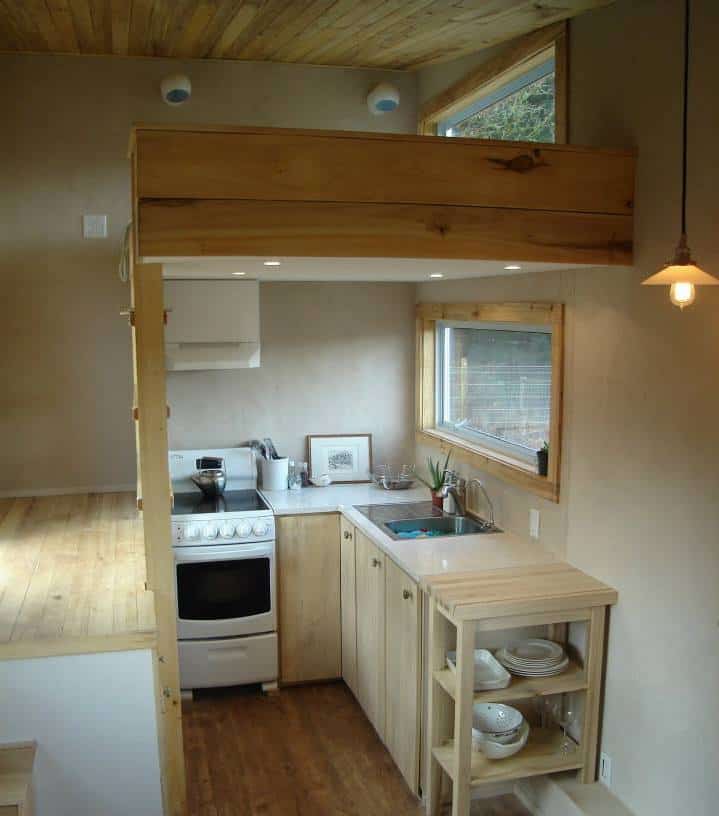
Corinne Segura holds certificates in Building Biology, Healthier Materials and Sustainable Buildings, and more. She has 10 years of experience helping others create healthy homes.
I have owned and lived in three trailers: my tiny house on wheels, a custom Camplite, and a converted cargo trailer.
Did you find this post helpful? If so you can buy me a coffee to support the research behind this blog. Thank you!

Rebecca Stumpf
Hi Corinne! Do you know what year Camplite by LivinLite changed their wall system? And to verify, the ones pre-the-change are what is the metal-foam-metal/good ones? Thanks! Rebecca
Corinne Segura, Building Biologist
yes, it’s in the article on camplite as i dont remember off the top of my head
billy davis
hi corinne.. my wife is mold and chemically sensitive. she was and is unable to be in any camper new or used so i built one in 2017. we have done 2 trips to the yukon and alaska in our truck camper and now we are looking to sell it. the construction is welded aluminum frame, sheet aluminum exterior, 2″ rigid foam insulation and an all wood (mostly cedar) interior.
i do not know how best to advertise the mold and chemical sensitivity feature of the camper so would take any advice you have. i also know from experience that there are not a lot of these around and i think others should have the camper experience if they want. we are on the sunshine coast in bc
Corinne Segura, Building Biologist
ah nice, post it in the facebook group “EI Safe Housing”
Gail Straw
Hi, I do not know if this site is still active, but I am giving it a try. I am wondering if anyone in the Clearwater/Tampa, Florida area has knowledge of a clean camper that could be rented by my extremely sensitive and mycotoxin-ill adult daughter. New construction apartment has lots of VOC’s and we are at our wits end with even the hotel that was o.k. is now making her sick. Any suggestions would be very welcome! Thanks! Gail
Cynthia Sewak
Hello, what is an alternative to closed cell foam? The van builder uses it around the window frame to adhere fabric to and I’d like a safe alternative? It needs to be smooth to not show through the fabric. Cork?
Corinne
I would need more info to answer that. But there is a article on building out a van.
Lara
Hi Corinne,
I’m looking into the Hero Camper to park outside a friends home but also to be mobile. I was reading some reports on paradigm change about how fiberglass is vulnerable to MT absorption. Most hero rangers available in the US are in Texas. There is also one in Colorado and then a super expensive one in Utah.
Do you have thoughts on purchasing one of these from a contaminated area? Most of them will have been sitting on the lot for a year or more.
Thanks so much!
ROBBY b
What about a fifth wheel by LUXE or NEW HORIZONS? They are very expensive but seem to be extremely well built. They have hardwood cabinets and a few other things that most do not. They have wood walls but it seems to be very well built. Any thoughts on these?
Corinne
the walls look good but not the roof
Jeff
Any updates on the We Roll aluminum trailer? There’s a new owner, an office that always picks up the phone, fast builds and an MCS version for an additional $3500. I’m not concerned with the minimal foam board insulation. I’m only concerned with MCS and mold issues.
https://weeroll.com/2022/12/28/letter-from-the-president/
B Love
Thank you so much for this post!
After having issues with mold in the last 5th wheel I was in, I’m looking into buying something new that can hopefully make it a year or two without mold becoming an issue, and then trading it in. There are 2022 models for sale now that are still “new” and a bit cheaper – but is that kind of like buying a 1 year old trailer already in terms of mold risk? Or does the risk come more from it actually being in use?
Corinne
It depends on the construction. I would not go with a conventional 5th wheel.
Dave
What a wonderful site you have created.
I’d like to ask if you have any experience with truck shells/caps? Do you feel a used truck bed (dirt/grime from tools) would be an issue?
Gale Payne
Weeroll trailers come with 1″ of white styrofoam
Corinne
I know but I would not just plop the styrofoam between two layers of metal and call it a day. It’s more complicated than that.
Mary Jane
Hi Corinne,
Regarding your previous review of the Weeroll cargo trailer, you had put
this comment,
“As of winter 2021 I don’t recommend this trailer for sensitive folks. I’m waiting to
hear more updates before removing this from the list.”
Has anything changed in your mind regarding your recommendation for sensitive folks? Any more updates?
Corinne
I would not go with weeroll
Samantha
Hi Corinne. The Taxa camper you listed above has lots of formaldehyde in it. Something buyers should know. I bought this camper because lots of sites, like this one, say it is a green company but that is just not true. I would hate for someone to be mislead the way I was and purchase this camper thinking it is chemical free or low voc.
Corinne
they all have significant offgassing when brand new for someone with high-extreme chemical sensitivities. Not formaldehyde but other VOCs.
Lauren Taggart
I can tolerate my Lance travel trailer as it is made with azdel and aluminum similar to coachman. however, it’s not big enough for our family now and i am selling it. ( or trading it for an RV?) which is better a camper van or an rv?
Kassie Mann
We’re considering a new Lance travel trailer full time . Thoughts on? I’m concerned I won’t be able to tolerate the chemicals…my reaction is much less than to others I’ve gone in but it’s a big investment.
D. Leslie Council
Is your Lance still for sale?
Thanks, Leslie
D. Leslie Council
Is your Lance for sale?
Tuchango
Any thoughts on the Escape brand of fiberglass trailers?
Corinne
They are mentioned in the post
Brent
Doh! Thanks. I’ll re-read.
Carla Henderson
Hi Corinne,
I’m making an offer on a mobile home tomorrow. Besides having an inspection and checking for mold and termites , do u have anything else we should do to check that the house is safe? Since the mobile home is aluminum, you concerned about EMF? I’m sorry if this message is a duplicate from yesterday as I Can’t find my original message to you.
Thank you,
Carla
Corinne
Metal framing would not be a concern for me, mobile homes almost always have mold though, and inspectors are particularly bad at catching it.
Carla Henderson
Thanks Corinne. I’m also scheduled a mold company to come out to the mobile home to do a futher check. They do 3 air tests and have an infared light. Short of opening up walls, are there other tests you recommend to detect mold? The mobile home was vacant for 3 years. It had a dehumidifier running constatnly and someone checking the home but no A/C on. Outside awnings blown off in 2017 hurricane, and looks like some openings around top of windows outside and on inside some evidence of water damage by paint buckling around some of window sills. HOuse smells a little mildew/mold. Appreciate any of your suggestions and happy to do a consult if you could provide me with specific guidance. on any futher tests to detect mold or dangerous mildew if it’s there. I only have 8 more days during my contract period to walk away from this house so have time limitiations on asking the right qustions and doing any testing. Thanks very mch,
Carla
Paule Hjertaas
Hi Corinne,
great resource.
Just to let you know that I thought I had done my research before I bought a Camplite trailer but, unfortunately, I could never stand the paint the aluminium was painted with after 5 years. I ould stay in it with windows wide open and if the weather was cool only (less outgassing). So I tried to cover surfaces with aluminium tape which had been OK in the past. It didn’t work. then I tried some other aluminium (Denny foil) and I realized I couldn’t stand that either. The other issue I had with it is how badly sealed it was. Driving a bit would fill up all kinds of places with dirt coming in from the wheels wells and other cracks. also issues of water infiltration through the ceiling lights, and a substandard electrical system that would shut down if I tried to plug in an electrical plate. I finally sold it at a big loss after 7 years of having to pay for storage without using it. Just letting you know my experience with it. I have been able to visit friends living in older fiberglass trailers but have never tried sleeping in one.
Elana
I was thinking of using TIny Healthy Homes for a tiny home. You mentioned that you no longer recommend them. Can you elaborate on what issues you have seen with their construction and production? We are seeking a non toxic, low emf home and this company seems to be very focused on those two big issues. I have not found any other builders with this double focus and willingness to customize materials etc.
Corinne
It couldn’t have been more of a disaster. The house went moldy in multiple ways, I lost all of the health I gained back and never had been able to get back to that. I lost everything I owned and was homeless for years. Ben Garratt in my experience had no interest in building science, mold prevention, or the detailed research and work needed to build in that way.
Elana
Wow. Thank you for sharing your very negative experience. Very disappointing to hear.
Elana
Elana
Hi Corinne,
I’m still researching tiny homes as a possibility. Ben Garratt addresses a number of concerns around thermal bridging and mold in this video and how he structures his tiny homes/ what he recommends.
https://www.youtube.com/watch?v=Uqgf9ijr668
I am hoping that builders of tiny homes will start to take healthy building science seriously. He seems pretty knowledgable about addressing these issues but I don’t know about his execution. Perhaps Ben is evolving from your horrible experience with him? I’m just so concerned about the cost of housing. I owned a brand new house for years before relocating to another state. However, housing prices are so high now. I can’t afford the high quality prefabs. I have access to some land so I was hoping to identify a tiny home option for my daughter and me.
jetta
Hi Corinne,
Did you ever get more feedback on the newer happier campers? I can’t tell you how much I love this page!
Corinne
No I havent, please encourage others to share this kind of information or tag me in the groups if you see anything.
jetta
Will do for sure. I’m going to check out a 2018 used model. Wish me luck. 🙂
Lydia
Would a house like this be mold safe? It’s built from solid wood. https://www.unforgettabletinyhouse.com
Kristin
What can you tell me about 4 season fish houses such as those made by Glacier for both mold and chemical sensitivity. Interior wood is all cedar, but I do smell a little something that needs to offgas.
How long does that usually take?
Is spray foam insulation good or bad?
Corinne
I don’t know that company I would need to review the materials that are used there.
Melissa
Hello, Could you please share why you no longer recommend the Weeroll trailer, as of Winter 2021? I am chemically sensitive as well as currently experiencing mold illness. Thank you for your valuable posts!!
Connie
I haven’t committed to anything yet but I’m in the process of making a change and I’m curious why the Weeroll is no longer recommended as of winter 2021. Thanks!
Matt
Hi, FYI, I just checked out an ATC toy hauler in Denver and there was a strong chemical smell in it that reminded me of a new car with vinyl seats on a hot day (it was only ~30F outside at the time). I’m nowhere near as sensitive as my wife and daughter, but I ended up with a headache after being in there for a few minutes. Maybe it would off-gas quickly, but I couldn’t take that chance on a $90k trailer.
Corinne
That’s typical for trailers, most people with chemical sensitivities cannot tolerate a new trailer.
Matt
I figured it was typical. It’s just unbelievable how difficult it is to find a camper that isn’t moldy and doesn’t smell awful (fragrance or off-gassing). Looks like I’ll have to build something myself. Thank you for all the useful resources.
p
Check out Lance Travel Trailers. New they are the most tolerable I have been in.
Laura
Hello Corrine. Can you tell me if Lance trailers are Aldo a good choice for those with previous mold exposure?
Corinne
The only trailers that can stand up to mold are on this list. Conventional construction brands do not hold up.
Leslie C.
Hello…this is simply a notice that I am looking to buy a smaller healthy trailer dwelling while I am tweaking a small home. I do not need plumbing or a kitchen. If anyone has something like this to sell, please let me know. Thank you.
Constance
Does anyone have any recommendations for Class C and Class A motor homes with added bunks, washer and dryers…. I hadn’t actually considered the issue of mold in RV’s but I came across this article and don’t believe it was by mistake… Can a used RV be easily reconditioned to avoid the mold pitfalls? Thanks for any advice…Kind Regards …Constance
Lev
Do you have any thoughts on the Minimaliste Tiny Home brand? I know they have made at least 1 MCS THOWs before. I’m curious what you think of their building process.
Celina Burns
What would you use to insulate the ceiling of a stationary single wide mobile home. What kind of material would be best for the ceiling?
Unknown
Has anyone bought a weeroll.com the aluminium or wood interior? if so how has that been for you please?
Corinne
I have seen a couple weeroll purchases, very tricky to insulate a metal trailer. Seemed to be OK MCS wise since they are able to customise.
Unknown
I forgot to add that there’s Dunlop and talalay latex. Glue is not used when they make the Dunlop but it is used for talalay so if you’re super sensitive you might want to avoid talalay or buy from a company that uses non toxic glue. Talalay is more expensive and less natural as a rule but it’s also more comfortable as in a little more soft and comfy.
PHANAT ASSEMBLY COMPANY LIMITED
My experience with Panus is good. Their transportation services and product has quality. The people working here are responsive and helpful.
Jones Morris
This is a great article thanks for sharing this informative information. I will visit your blog regularly for some latest post. I will visit your blog regularly for Some latest post. lightweight camper trailers Missouri
Lori Basil Brown
I've been privileged to own an Oliver travel trailer, grateful that there is no wood subfloor. However, a serious mold problem developed under the sink where there is a lot of wood (now removed 🙂 Also I was told recently by Oliver that the wall dividing the bathroom from the rest of the interior has plywood in it – sandwiched between two layers of fiberglass. We are not the only owners whose bathroom door frame has allowed water intrusion and caused mold inside the wall.
Corinne
Thank you for the info!
Cort Johnson
I have a Van that I would like to add a fiberglass high top to. Can anyone speak to offgassing concerns fron that?
Corinne
It totally depends on your level of MCS, from watching People's experience with fiberglass trailers some people move in almost right away and some people need years for it to off gas. It's not uncommon for it to need years.
cort
Th;anks!
Pete and Christina
What do you recommend for a family of 7? None of these options seem big enough. Thank you!
Corinne
The biggest one on this list that I would buy is Living Vehicle.
Madeline Cole
I'm interested if you still have it – lcolee@yahoo.
Alicia Marie
Hi Corinne, we have an amazing trailer that we bought for our extremely sensitive son but he became more severely disabled
and cannot care for it. We will need to sell it for him. Where do you recommend we look to market it? He never got to even use it. He is in Texas and we are in California and the trailer is with us. Alicia Marie
Corinne
Hi Alicia, please post on MCS Tiny House and EI Safe Housing
dharmag
I'm interested. Can you give me more details.
Corinne
You can email it to me as well if still selling it [email protected]
Sheri
I'm in California and would be interested in learning more about your trailer, especially if you haven't sold it yet…thank you! Sheri B. Please email me @ [email protected]
Heidi
Has this trailer been sold, or is it still available?
Mary
Hi Alicia,
Were you able to sell this? I may be interested.
Caryatid
I am thinking to build a tiny house on my property for a friend of mine who is super sensitive. It doesn't need to be mobile and I will build it in place. Can anyone steer me towards materials lists that are most likely to be safe? Can you tell me whether drywall and concrete cause problems for chemically sensitive people?
Thank you. I am totally new to even thinking about this, so any good resources that come to mind, please feel free to send them to me.
Corinne
Hi this site serves as that guide. Each post is a category on different materials. I go over drywall and concrete. For more personalised advice I do consulting.
Unknown
Have you (or has anyone in this thread) found a lightweight, chemical-free futon or sofa bed solution? I cannot tolerate chemicals (I became chemically sensitive after mold poisoning and have to live extremely minimally and can only have things made of materials that I can clean — leather, metal, wood). They have to be lightweight because I have to move so frequently and start over again — getting rid of old belongings that have become toxic to me. I'm looking for two things: (1.) a mattress topper that won't off-gas; and (2.) a lightweight/portable sofa bed that can be easily cleaned. I bought a full size mattress from IKEA that I'm not reacting to, but it's too firm and giving me major body pain. The mattress topper has to be returned because it's still off-gassing several months after purchase. I don't currently have a couch, but if I get one, I'd like it to double as a bed (so, a sofa bed I guess). It has to be super light-weight, small, mold-resistant, chemical-free and made of materials that can be cleaned with hydrogen peroxide or white vinegar. Any help or advice would be so appreciated.
Unknown
Hi, I know your post is over a year old but here's hoping you see this reply! I CANNOT tolerate new furniture, so I shop at furniture stores and ask them if i can buy something new, but take that same model that's been on the floor for a long time. Every store has worked with me on this, because they get a brand new item on their floor, and I get an already off-gassed piece of furniture. It may have a few cosmetic blemishes, but usually the transition into my home is flawless. Hope that helps!
Caryatid
For a sofa, I am wondering if you might use an old style horse-hair sofa with wool upholstery. If the wood frame has stayed dry, it might be mold free.
As for toppers, I bought one off Amazon; the egg-crate type. They sell them used on Amazon too, so maybe they will have off-gassed already. The one I bought had a strong odor that really bothered my breathing, but I aired it outdoors for a couple days and it became unscented and OK for me.
Good luck!
Jen
Hi, I don’t know if you are still looking for a sofa/mattress, but in case others are looking and come on this post, I recently bought the all natural wood unfinished futon for $150 from Amazon, and then one of the medium and one of the soft organic dunlop laytex toppers for about $430 from Amazon. I put links below. I used these without problem and did not need to off gas them. I could no afford to invest a huge sum for the reasons that you mentioned: I may have to move and may have to get rid of these if they are contaminated. I bought the full futon and two 3″ toppers to result in a 6″ mattress on the futon. It is firm, but not too firm for me. I have been able to use the futon also as a couch, although it does mean that you have to adjust it and the latex is heavy. I figured out how to do it and I really liked it, but it may be hard for some people. I also use a lumbar support pillow when the futon is in upright mode, and made a neck roll that is attached to a belt and weight so that it can hang over the top of the couch in upright mode. Also, you have 30 days to return the mattresses if you don’t like them with free return shipping. The futon is hard to return because you have to put it together, but you could probably resell it used if you don’t like it.
Here are the products: KD Frames Studio Bifold Futon (Full)
Brand: KD Frames https://www.amazon.com/gp/product/B001IJFBDI/ref=ppx_yo_dt_b_asin_title_o00_s00?ie=UTF8&psc=1)
Certified Organic 100% Natural Latex Mattress Topper – Soft – 3 Inch – Full Size – Organic Cover Included.
Visit the Take Ten Store
https://www.amazon.com/gp/product/B07RF8ZRJ9/ref=ppx_yo_dt_b_asin_title_o04_s01?ie=UTF8&psc=1
I also found it really nice to order two round 10″ diameter yoga bolsters to put on the futon when it is in bed mode. I can do restorative yoga poses with them. I actually ordered mine on etsy from bulgaria so that I could have all wool ones (cover and all).
Good luck!
Corinne
thank you!
Gabriel
This is called modern living. A new pollution free era has begun for our teenagers.
Alice Taylor
My friend is also planning on purchasing a mobile home since she saw how cool my modular house is. Actually it was pretty small and neat. I guess it's not vacuuming for hours that convinced her to transfer from a bigger house. One of the things that the guys who build my house advised me is to make sure I have a piece of land that allows these modular homes to be build. I guess in terms of budget, these homes are cheaper than traditional onsite houses. See this resource site if you need to learn more: http://modularhomeblog.com/modular/building-a-modular-home.html
Sowpath das
Nice post
Sarah Smith
My husband is really sensitive to chemicals and we are trying to find a good trailer. Thanks for the advice about aluminum travel trailers and how you can customize them to avoid most toxic elements. We'll have to see about getting an aluminum trailer to either sleep in or to help us haul or camping supplies.
Wild Swan
For the beach, we got a car hauler instead of a trailer so we could customize it: removed the walls, which were aluminum covered plywood for dimension strength, replaced with cherry tongue and groove (make sure he is ok with the wood first! Some woods are quite bothersome), replaced the floor with the same, and replaced the luan on the ceiling with stainless steel sheet. We chose not to insulate so we only use it nine months a year – it stays warm with a heater if it's 35f outside. Use a composting toilet.
Brianna Baker
My husband and I are converting an old school bus to be a completely green home for our family of five. We have replaced the fiberglass insulation with alpaca wool, painted metal walls and ceiling with beautiful tongue and groove pine, red oak floors finished with 100% tongue oil, marmoleum (which is a laminate made from flax and other natural materials) for the bathroom, organic cotton hammocks for sleeping, copper kitchen sink, and a wood stove for heat. Www are taking our bus up to the upper peninsula of Michigan to grow our food and live life where the chemically sensitive are free to live, ha ha. If anyone wants any info about chemically safe adhesives and caulks that I've found out to talk chemical free living feel free to email me at [email protected]
Noah Outlaw
What kind of tongues are used in the manufacture of "tongue" oil.
Lynnsey
Ha ha ha! Nice catch!
Elegant WoodenHomes
Great article. Hope I had a good read. Waiting to read more blogs.
Gwen Miller
I love that first trailer you have photographed! It is so darling. It would be so fun to have something like that, that would be easy to pack up and go whenever we wanted to. It's the perfect size for just my husband and I!
http://www.bettertrailers.com.au
Cristian D'cruze
Wow! Incredible and this is a nice blog with all good pics of the mobile home. I like to move one place to another place for visiting different places. I think it is perfect for me. Is this safe for me? This portable house reflects the talent of the house maker. Can you share the process through which you have made this so that I can make one for me. Thank you for sharing this beautiful and inspirational blog with us.
Corinne
Hi, yes upcoming posts will focus on the build of my tiny house/mobile home!
hah not be blank!
look into cork insulation. .. small planet workshop imports it from Europe. Also, cork is gas impermeable. Been thinking if I get a trailer I could use afm glue n just slap it on as many surfaces as seem offensive.
Corinne
Hey thanks for the tip! Do you know the link or the brand name of this insulation?
The problem with cork is that a glue is needed…
Anaphylaxing
Oh my gosh! Is there a way to contact you? I am wanting to do the same as you in Canada 🙂
Great blog!!
Corinne
Hi, Yes, you can email me at corinne_segura[at]hotmail[dot]com
Janis
I have a LivinLite toyhauler but it does have the styrofoam insulation, and it bothers me if I don't keep the windows open. Ours is a 2010, bought used. We had to rip out the floor insulation because it was held in place by a netting that allowed moisture in. In the past I checked with two trailer companies who were willing to customize cargo vans to Erik's specs, using no caulking. Take a look at my post here:
http://cfsmethylation.blogspot.com/2012_06_01_archive.html
Corinne
I'm not getting the floor insulation but the wall insulation is totally sealed off by the aluminum walls. If there are any spaces, aluminum tape can be used – aluminium fully blocks VOCs. I am wondering if yours doesn't have all alum wall panels or if it the treatment used to colour the walls, or something else that's bothering you. I would love to hear more feedback about it! Thanks!
Dave
hi, I’d really love to read this blog but it’s invite only?